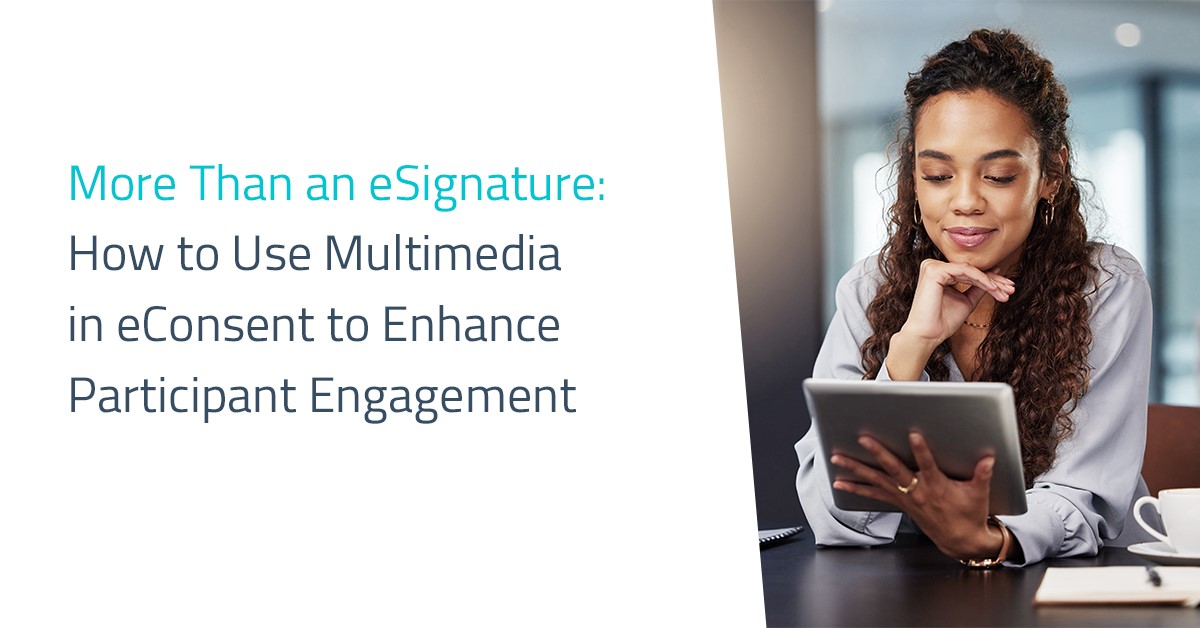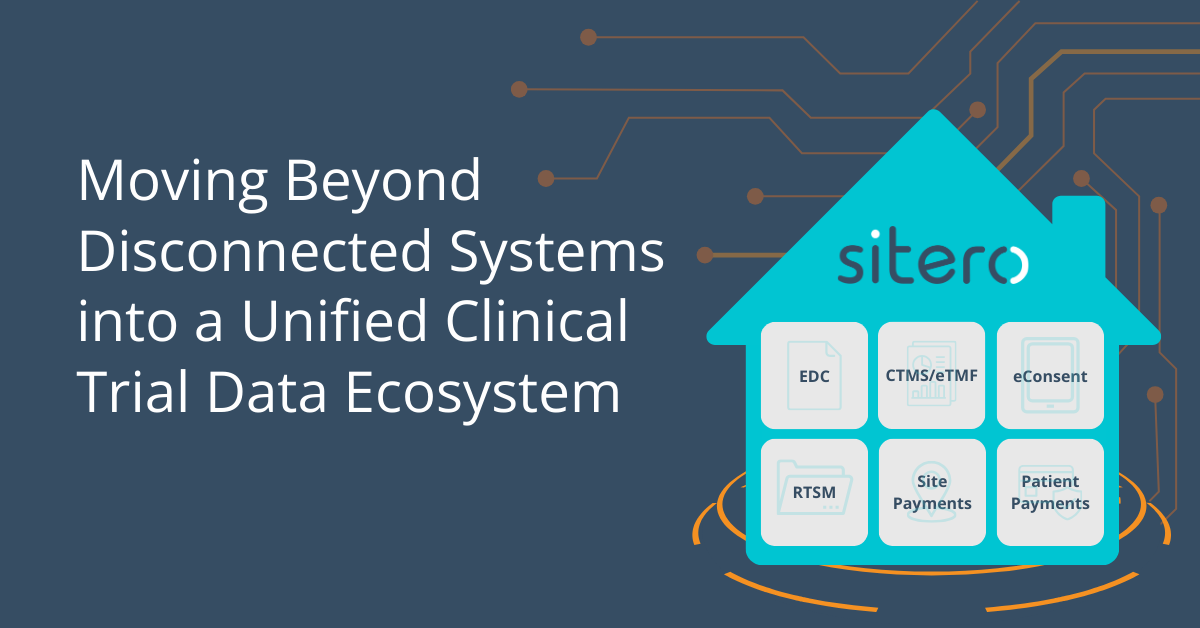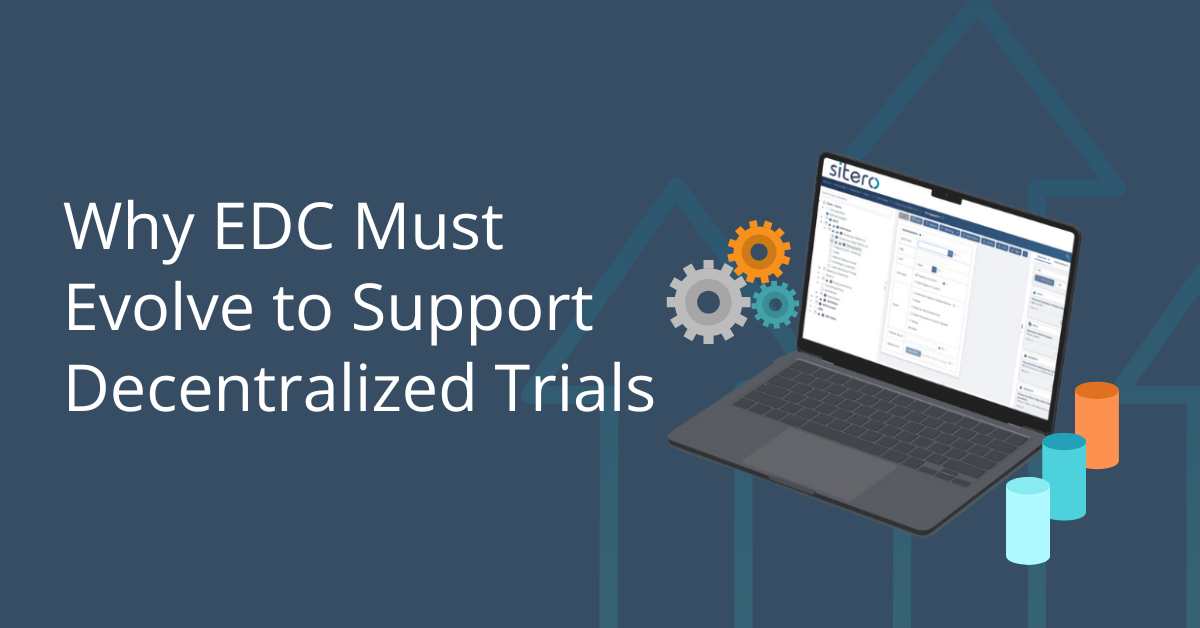
How Multimedia in eConsent Enhances Participant Engagement
Authors:
Kapi Patel, Vice President of Product Management, Sitero
Sam Sather, Vice President of Clinical Pathways, LLC
Few sponsors or CROs are taking advantage of eConsent solutions to engage and educate participants or to introduce efficiencies and transparency into the consent process. The benefits of eConsent for all clinical trial stakeholders include ensuring greater participant understanding of expectations, more geographic flexibility, and streamlined recruiting.
Based on our experience with all eClinical systems in global trials, implementing eConsent, and the feedback we’ve gathered from biopharma stakeholders, we developed this blog as a practical guide for sponsors, CROs, research institutions, and ethics committees (ECs) to successfully adopt eConsent.
Use the information presented here to anticipate and overcome barriers to adoption, as well as prompt consideration of the why, what, when, who, and how of integrating eConsent into clinical trials. Gaining a good understanding of the various factors related to eConsent can enhance change management and streamline the successful implementation process.
What is eConsent?
Because there are many different definitions of eConsent in the industry, we would like to set the stage by defining eConsent as the following:
“eConsent is a technology-enabled participant engagement tool that uses multimedia to present the study and consent information, facilitate communication between the participant and research site, and can obtain an electronic signature when appropriate.”
Perceived deficiencies in the informed consent process, content, and documentation can hinder the adoption of eConsent. Common concerns about eConsent include its acceptability, effectiveness, and security. However, these often stem from a lack of understanding about what is considered a “new” way of obtaining consent
Informed Consent vs. eConsent
In clinical trials, informed consent is more than obtaining a signature on a form. Regardless of the format, consent in a clinical trial requires providing a potential participant with enough information to make an informed decision about their involvement in the research and provides opportunities to ask questions before making a decision.
Informed consent is a critical-to-quality (CTQ) factor for patient safety in clinical trials. Yet, consent documents are often difficult to read and comprehend for most people, especially given their increasing length — most exceed 10 pages in length and can take an average 35 minutes to read. Contributing to this length is the list of mandatory items outlined in the Code of Regulations for the protection of human subjects.
Consent documents have been inappropriately used by sponsors and institutions as a legal document to protect against civil litigation, which limits accessibility and the primary function as an informational document for study participants. Longer consent documents do not lead to better comprehension, which becomes increasingly difficult to measure the longer the document is. The regulations around informed consent have not changed; however, evolving regulations around the use of electronic systems in clinical trials (eClinical systems) have introduced some uncertainty around eConsent.
eConsent has the potential to enhance the informed consent process by providing methods to present information in ways that meet participants’ literacy levels, learning styles, and attention span including: text, images, audio, video, and interactive functionality such as hover definitions and quizzes to test understanding. The content and process of eConsent also undergo the same rigorous institutional review board (IRB) and EC review processes as traditional paper-based consent, helping ensure participant understanding.
With eConsent, participants can review and re-review content in a more relaxing manner and request input from friends and family. Therefore, eConsent goes beyond merely moving paper documents to digital platforms and providing an electronic signature. Further, eConsent is not just for remote consent and decentralized trials (DCTs). eConsent can be used for both remote and in-person trials, providing participants the time and space to identify questions for site staff. Sites can view the consent progress and check in with participants when it appears the process has stalled. The implementation of eConsent is also fully customizable to the requirements of the region, sponsor, program, study, therapeutic area, and participant population.
Why Incorporate eConsent into Clinical Trials?
Regulatory authorities, such as the US Food & Drug Administration (FDA) and the UK Medicines and Healthcare products Regulatory Agency (MHRA) have encouraged the adoption of multimedia eConsent — emphasizing improved participant understanding as a key benefit.
The paper consent processes make version control and audit trails challenging. Therefore, the Clinical Trials Transformation Initiative (CTTI) recommends eConsent as a method to create a more effective consent process, and research has shown that participants prefer having the opportunity to choose paper or electronic presentation of information depending on their learning style.
Some benefits of eConsent include:
- eConsent could help improve participants’ “understanding of study objectives and design, increase regulatory compliance, and reduce quality risks” (according to the TransCelerate eConsent Initiative)
- eConsent makes it easier and faster to review a participant’s entire consent history
- Participants may prefer multimedia content and on-demand access to online consent tools over the traditional paper process
- Successful adoption of eConsent may result in better-informed participants and their families/caregivers
- Use of multimedia and knowledge checks could improve information retention, participant comprehension, and participant satisfaction
Ultimately, eConsent modalities present an opportunity to reimagine how to engage participants in clinical research and incorporate informed consent within participant-centric trial processes. In addition, because of its electronic nature, eConsent includes a comprehensive, electronic audit trail, with date and time stamps of participant interactions with the original informed consent content and modified consent documentation due to mid-study changes.
Electronic audit trails support:
- Fully informed consent and re-consent
- Document management
- Version control
- Insight into how to improve the consent process
Who Benefits from eConsent?
The clinical research industry has successfully implemented technological solutions that have improved many aspects of clinical trials, and eConsent provides benefits for multiple stakeholders. When implemented as a comprehensive solution, eConsent enables a seamless workflow from creation by the sponsor or CRO, approval by the IRB or EC, use by the research sites in informed consent processes, and for participants to understand the study’s requirements.
Everyone in the process sees the same information and how it will be presented to the participant. There are no surprises, and a full audit trail of comments, responses and changes is provided for the sponsor, CRO, IRB, and sites. In addition, sponsors and CROs benefit from being able to implement mid-study changes and notify the participants and sites that there are new consent documents to review and re-consent. It becomes easy for sponsors and CROs to track in real time who has consented, as well as, where and when, which is not possible with paper documents.
Sites can reduce the time spent by their staff during the consent process because the information is presented to the participant in easy-to-understand formats. Because participants are likely to have clearer expectations, their interactions with the site are also enhanced. The industry as a whole gains insights for continuous improvement of the consent process, something we have not been able to do with paper-based consent due to a lack of actionable data.
With eConsent, at the study level, comprehension testing can flag areas of misunderstanding by participants. The information can be improved for future participants while the study is ongoing. At the regulatory level, we could begin to understand what (and how much information) is required for informed consent and adapt guidance accordingly.
When to Adopt eConsent
Not all organizations will be ready to adopt all aspects of eConsent at the beginning. eConsent can take many forms, and its implementation can be done in stages vs. all at the same time. Some stakeholders recognize the benefits of multimedia for better participant understanding of the study requirements, which is pivotal to informed consent.
There is an opportunity for organizations to implement the “multimedia content” aspect of informed consent via eConsent and then add more features (and across more studies) as the organization and regulatory authorities mature. Adopting eConsent is often an iterative process of development, implementation, and optimization.
How to Implement eConsent — Keep it Simple
Informed consent is one of the most regulated clinical trial requirements. Regulations cover the required elements, process for review and approval, and documentation of the process. Sponsors are obligated, per the regulations, to ensure their eConsent vendors meet the global regulatory requirements for informed consent, data storage, and eSignatures. Because these requirements do not include the specific multimedia content in eConsent, it is possible to customize the roll-out of eConsent to your organization’s maturity level.
The key to acceptance and adoption is to solve the problem of better informing the participant. This could mean something as simple as breaking the information into smaller chunks that participants can navigate at their own speed. Then, new multimedia features can be rolled out incrementally and as they are appropriate for each new study. More is not better if it is too confusing or challenging to implement. Instead, continuously improving the design and deployment of eConsent paired with a maturity model for the stakeholder is a pathway toward successful adoption.
Getting the foundation for eConsent right also means that additional multimedia features can be tailored to each study’s needs. Although this would appear to complicate the process, it is actually simpler than trying to make eConsent a one-size-fits-all solution across all studies and participant populations.
Conclusions
A key takeaway for eConsent is to plan early. eConsent adoption will take time. However, proper planning and collaboration with all stakeholders and vendors will lead to successful adoption. Most importantly, incorporate eConsent into the study design early, with buy-in from all stakeholders. Be sure to consider both the country-specific requirements and site-specific requirements for eConsent, eSignature, site understanding and acceptance, and consent document storage as well as therapeutic area and participant population characteristics.
Build adaptability into the process so that more limiting requirements in one country do not limit the use of eConsent in other countries. To ensure that the eConsent design and implementation are a good fit for the stakeholders’ stage of maturity and the specific study requirements, it can be helpful to find an agile partner with experience implementing eClinical systems, including eConsent, globally.
Sitero’s Mentor eConsent is creating the future of clinical trials by converting complex paper documents into usable digital content. We are dedicated to improving site and patient experiences by truly harnessing technology. Contact us to learn more about our Mentor eConsent services.
About the Authors
Kapi Patel
 Vice President of Product Management
Vice President of Product Management
Kapi Patel is the Vice President of Product Management at Sitero. She leads product strategy and innovation for the Sitero Clinical Mentor Technology product portfolio and works cross-functionally to plan and execute the initiatives. Kapi has a versatile background with extensive software development and operational leadership experience. She is an accomplished leader who develops strong teams and culture while delivering technology solutions to achieve strategic goals and customer satisfaction. During her career, Kapi has successfully led product management, software development, portfolio governance, customer success, application support, professional services, and IT Infrastructure teams.
Sandra “Sam” Sather, MS, BSN
Vice-President, Clinical Pathways LLC

Sam has been in the industry for almost 30 years. She has worked for sites, Sponsors, and CROs, including roles as a study coordinator, site director, monitor, auditor, quality manager, director of clinical operations, director of monitoring, and trainer. Sam is a well-known GCP and clinical quality system subject matter expert with a focus on vendor management and risk-based quality management. Sam is a frequent speaker at industry conferences, and a contributor and author to many GCP publications. She co-owns a GCP consulting and training firm in Research Triangle Park in North Carolina since 2002 that services globally small to large pharma, biologic and medical device companies, technology vendors, research sites, and CROs.
References
- CTTI quality by design project — critical to quality (CTQ) factors principles document. Clinical Trials
Transformation Initiative. Accessed on March 9, 2023. - Grant SC. Informed Consent—We Can and Should Do Better. JAMA Netw Open. 2021;4(4):e2110848.
doi:10.1001/jamanetworkopen.2021.10848 - Emanuel EJ, Boyle CW. Assessment of Length and Readability of Informed Consent
Documents for COVID-19 Vaccine Trials. JAMA Netw Open 2021;4(4):e2110843. doi:10.1001/
jamanetworkopen.2021.10843 - Office for Human Research Protections. 2018 Requirements (2018 Common Rule). Accessed February 21, 2021.
- Hochhauser M. Consent Forms in Context: How Long is Long? SOCRA. Accessed April 17, 2023.
- Lentz J, Kennett M, Perlmutter J, Forrest A. Paving the way to a more effective informed consent
process: Recommendations from the Clinical Trials Transformation Initiative. Contemporary Clinical
Trials 2016:65-69. doi: 10.1016/j.cct.2016.06.005. - Simon CM, Schartz HA, Rosenthal GE, Eisenstein EL, Klein DW. Perspectives on Electronic
Informed Consent From Patients Underrepresented in Research in the United States: A Focus
Group Study. Journal of Empirical Research on Human Research Ethics. 2018;13(4):338-348.
doi:10.1177/1556264618773883 - eConsent Solutions. TransCelerate Biopharma Inc. Accessed on March 3, 2023.
- FDA – Use of electronic informed consent: questions and answers. December 2016. Accessed on June 25, 2023.
- International Council for Harmonisation. ICH Harmonised Guideline: Good Clinical Practice (GCP)
E6(R3) (draft version). May 19, 2023. Available at: https://database.ich.org/sites/default/files/ICH_
E6%28R3%29_DraftGuideline_2023_0519.pdf. Accessed on June 11, 2023. - Clinical Trials Transformation Initiative. Quality by Design (QbD) Maturity Model. Available at: https://ctti-clinicaltrials.org/wp-content/uploads/2021/06/CTTI_QbD_Maturity_Model.docx. Accessed on April 17, 2023.
The future of clinical trials is a unified, interoperable ecosystem. Sitero’s Mentor platform is leading this transformation, ensuring that clinical trials are more efficient, compliant, and streamlined than ever before. Learn more in our latest blog:
Today’s trials require data entry from anyone, anywhere including patients, sites, home nurses, and remote investigators. Learn why EDC systems must evolve to support decentralized trails in our latest blog:




